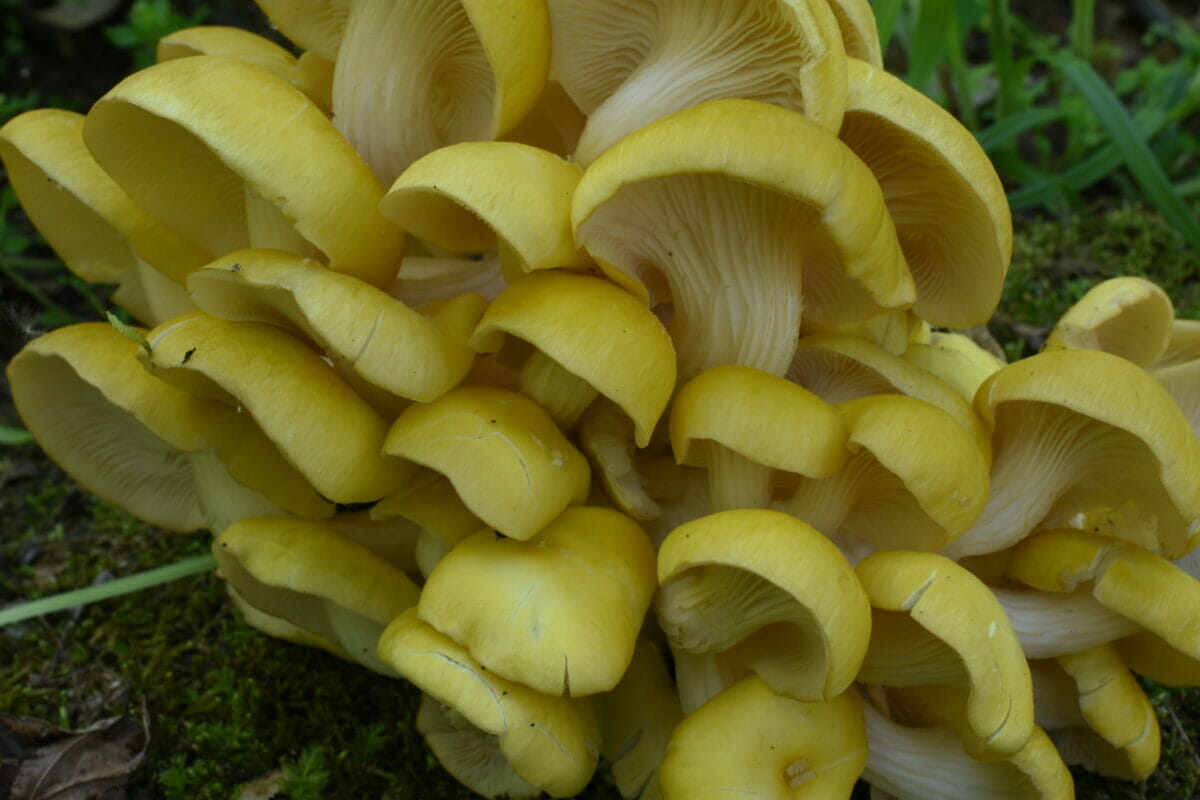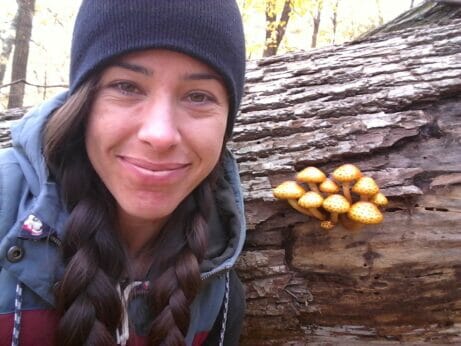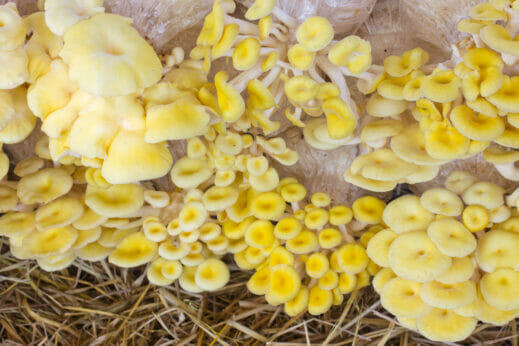The golden oyster mushroom, non-native to the US, is now found all over the country. Its proliferation is linked, in part, to at-home cultivation.

Golden oyster mushrooms, with sunny-golden thumbprint caps, branch-like gills and clusters of fruiting bodies, are originally from Japan, Eastern Russia and Northern China, and they are prized for their culinary uses. They’re also easily cultivated, which, in this case, is a problem. They have been spotted in forests throughout the Midwest and Northeastern United States and are now so prolific in Southern Wisconsin that foragers can leave the forest with garbage bags full of the mushroom in one foray. Scientists are sounding the alarm, and in mycology and foraging communities, they are considered invasive; however, officially, there is little regulation around growing the fungi.
Now, some experts in the field are saying it might be too late to prevent the mushroom from overtaking American forests.
“You will never outrun a fungus ever. The fungus is going to win. We don’t even know what measures we are going to take to abate the quantity that’s out there. It’s either going to find balance or take over,” says Tavis Lynch, chairman of the cultivation committee for the North American Mycological Association. Lynch cultivates a wide range of mushrooms for retail sale on his farm in Cumberland, WI, and he says he initially spotted golden oysters in the forest in 2014. Lynch grew golden oysters for years, but once he saw them in the woods, he stopped growing them, even though they are a big draw for customers at farmers markets.
“I didn’t want to be the guy who is responsible for the golden oyster. We had our strains sequenced, and they are not the strains that are the escapees,” says Lynch, who also authored the book Mushroom Cultivation. “Why did this one batch escape? That’s the big mystery.”
There are several theories and legends in the fungi community about how the golden oyster escaped; a fire on a commercial mushroom farm in Iowa, a flood of a mushroom farm in the Hudson Valley and a tornado on a farm in Ohio. Some armchair mycophiles suggested the golden oyster could be following the path of the Emerald Ash Borer through the United States because of how it thrives on dead wood.
However, ecologists say the introduction of the golden oyster could have been something as simple as an improperly discarded mushroom grow kit or spent substrate that was left outside.
Dr. Greg Thorn is a professor of Biology at Western University in London, ON, with a focus on carnivorous mushrooms. Thorn says that for early mushroom cultivators there wasn’t much consideration that the spores would escape. “If you crumble up the grow kit after it stops producing for you, it would likely be taken over by the molds and bacteria in the compost itself. But If you toss it out in a backyard as a lump, it may fool you and produce mushrooms outdoors.”
There are no clear guidelines on the disposal of mushroom grow kits and throwing it in the trash or compost is common practice.
“At this moment, we don’t have any single narrative about how the golden oyster escaped into the wild. There are lots of stories,” says Dr. Anne Pringle, a professor of botany University of Madison, WI. Pringle’s lab focuses on changing biodiversity of nonpathogenic microbes, such as fungi moved by humans across Earth. “There is no well-documented data about the escape of the golden oyster, but even if something as small as a grow kit was left to mature outside, it can introduce the fungi to a new environment.”

Andi Bruce on a mushroom foray. Photography by Andi Bruce.
Many in the mycology community cite Andi Bruce’s master’s thesis as one of the strongest datasets for understanding the golden oyster introduction. In the summer of 2017, Bruce was on her weekly foray in the forests of La-Crosse, WI, hoping to fill her basket with chicken of the woods, hedgehog mushrooms, mulberries and raspberries, when she spotted a mushroom she had never seen in the wild. It was unmistakable; the golden oyster was growing wild. Bruce, a Master’s student at the University of Wisconsin, La-Crosse at the time, started posting online wondering if anyone else had also seen the clusters of golden oyster mushrooms in the forest. Bruce then began using whole-genome sequencing to gain insights into the introduction and spread of naturalized golden oysters in the United States. She analyzed 29 wild golden oyster mushroom specimens collected across six states and used six commercially cultivated isolates. Bruce found that some of the cultivated strains became the founders of the naturalized populations of golden oyster mushrooms but that the isolates of cultivated strains of golden oyster had no clear geographic pattern. “In other words, lots of people probably got their hands on the same or similar commercial strains, perhaps to grow them outdoors, and those golden oysters escaped multiple times over,” says Bruce.
According to Pringle, there is currently no peer-reviewed study of the golden oyster mushroom. In 2022, the Pringle Lab began research on how the golden oyster can impact carbon cycles of the forest, which can contribute to climate change.
As a white rot fungus, the golden oyster is a powerful decomposer of wood and often found growing on hardwood trees such as elm, oak and ash. Aishwarya Veerabahu, a PhD student studying impacts of the golden oyster at the University of Wisconsin, Madison says there is anecdotal evidence that the fungus can take down dead standing trees much faster (around 5 years) than native decomposing mushrooms, compromising essential habitats for insects and birds. Veerabahu’s dissertation will study the growing concern around how the golden oyster is displacing native North American oyster mushrooms and has the potential to outcompete other fungi and change forest ecosystems.
“Humans have dropped a fungal bomb by bringing in a species that’s unknown to the area and unknown to the ecosystem,” says Melissa Klotka, president of the Wisconsin Mycological Society. “We encourage people to [forage] as much as they want when it comes to an invasive species like the golden oyster.”
Those invested in better understanding the golden oyster have words of advice for at-home cultivators, whether cracking open a golden oyster grow kit or starting to cultivate from spawn and fruiting blocks.
“Many people who would not consider it ethical to garden with invasive plants think it’s perfectly acceptable to let non-native mushrooms grow outside. If exotic mushrooms are placed outdoors, they will release spores into the air [that] escape into local forests,” says Pringle, who encourages small-scale cultivators to grow native fungi.

Photography by Shutterstock.
Researchers say it’s also important to be mindful of how you dispose of the fruiting blocks to avoid introducing non-native species into an environment. Thorn recommends that growing kits be limited to local and native species of fungi. When growing non-native species, see if there are sporeless varieties, such as a Japanese version of the Golden Oyster, which was created to prevent allergies. “Treat the spent grow-block as a biohazard—crumble finely and spread on lawn or in garden or in a composter. If you grow them in an apartment, break up the spent block and feed it to your worm composter,” says Thorn.
Lynch adds that it would be wise not to grow certain types of oyster mushrooms near wood, including inside your house or on furniture because the spores can spread and cause problems down the line.
Andi Bruce, who wrote her thesis on the mushroom, advises people to stay away from growing the golden oyster altogether. “For folks interested in growing mushrooms at home, I’d encourage them to propagate the native varieties of edible mushrooms already present in their area, rather than buying a grow kit online and risk introducing a non-native genotype.”
To Ash: The spread of them is bad for at least 3 reasons :1) Dead trees infected with Golden mushrooms rot and fall down faster than ones infected by native funguses. This means animals, birds, bats and insects that use the standing dead trees for homes to raise babies and shelter can’t use them as many seasons, resulting in fewer offspring. 2) They will probably out-compete native funuses for growing space and nutrients, resulting in fewer natives which act as food sources for native animals and have established roles in the forest ecosystem, such as making available nutrients from dead… Read more »
I think, as a media outlet influencing important conversations, it’s important that you discern between “invasive and “non-native.” While all invasive species ARE non-native, NOT ALL non-native species are invasive. A non-native species is considered “invasive” if it out-competes the native species, causing an ecosystem breakdown. (Last I checked, golden oysters are fairly weak and can hardly overcome common green mold, aka trichoderma.) While I am not advocating for haphazardly introducing non-native species, I AM advocating for truth. Let’s not be alarmist. Golden oysters are decomposers. They take out DEAD trees. Not living trees. This entire article is anchored in… Read more »
If they are so easy to grow by simply discarding grow kits then why do I have so much trouble growing mushrooms at home without my stuff getting contaminated
Better to adopt Golden Oyster Mushrooms rather than making efforts to ban since it has already spread.
Do further research on various aspects of cultivation.
It escaped cultivation at Kennett Square in Pennsylvania. Golden oysters have the smallest spores of all oyster species, hence their spore count is higher giving them advantage. Shiitake has also naturalized itself from cultivation in north America
Spore kits are not a problem people are not concerned about the spores in the wind . You’re not going to stop a dominant strain opse to late . hopefully they taste good yummy we hope
I want Mushroom benefit and I build Mushroom factory
Nice Blog
Nice article, keep sharing more useful content like this and anyone who wants legal support for you kindly visit our site thanks. If you are looking for agribusiness management colleges then contact Isab They are the best in this field. They provide a wide range of services such as Mba in agriculture business management, high-quality education, and viable presentation to its students.
Great insights on the topic. Keep up the good work!